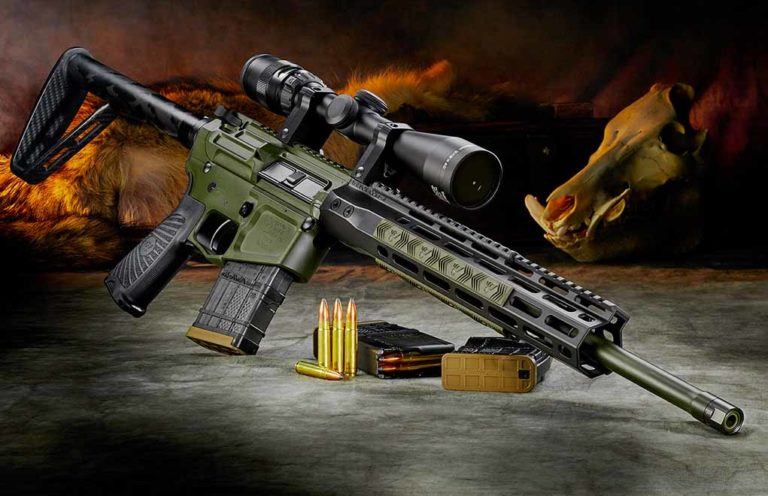
Developed for optimal terminal performance from the AR-15, the Wilson Combat .300 HAM'R shoots to be the modern day .30-30.
- The .300 HAM’R has 18 percent more retained velocity, 40 percent more energy and a 56 percent flatter trajectory than the .300 BLK at 200 yards.
- Any AR-15 platform rifle can be converted to .300 HAM’R with a barrel change and the use of .300 BLK mags.
- The .300 HAM’R, with its 1:15 twist match-grade barrel, is optimized for accuracy with 110-grain to 135-grain bullets.
- Factory Starline-produced .300 HAM’R cases are available, but cases can be made from common and available 5.56 Rem./.223 NATO brass.
- The .300 HAM’R has a 300 fps velocity and 400 ft-lbs. of energy advantage over the .300 BLK at the muzzle.
- The .300 HAM’R rifles and barrels are available in 16.25-inch, 18-inch and 20-inch lengths with different profiles.
If you ever wanted to own Bill Wilson’s — the Bill Wilson of Wilson Combat, that is — favorite hunting cartridge, now’s your chance. After a 13-year courtship, the new .300 HAM’R is his ballistic one and only.
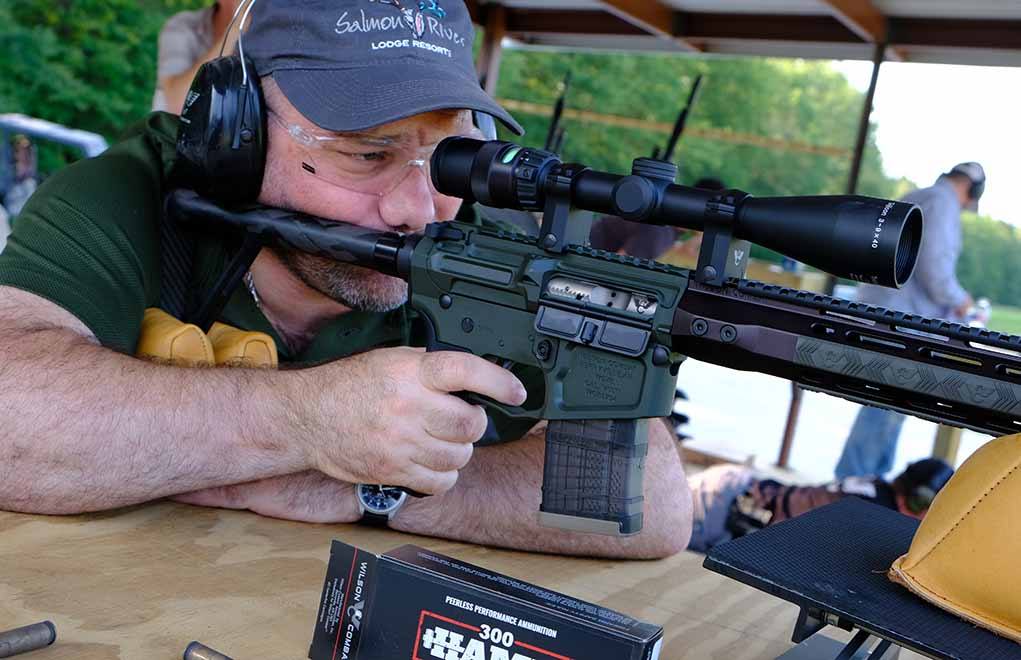
“It’s absolutely my favorite cartridge,” said Wilson. “On my ranch, I probably won’t use anything else from here on out.”
Since Wilson is one of those men who can and does have just about every kind of gun and cartridge combination there is, knowing he’s committed to just one cartridge should have your attention. So, let’s dissect the .300 HAM’R.
Another AR Cartridge?
The .300 HAM’R is an AR-15-capable cartridge created from the .223 Remington case by necking it up to .30 caliber. It’s designed to handle bullet bulletweights from 110 to 150 grains, with the overall cartridge length being 2.260 inches, the case length being 1.603 inches and sporting a 30-degree neck. Officially, Wilson Combat tells us “the .300 HAM’R was developed for optimal terminal performance and offers near .308 Winchester effectiveness, amazing accuracy and low recoil in the lightweight and compact WC15 platform.”
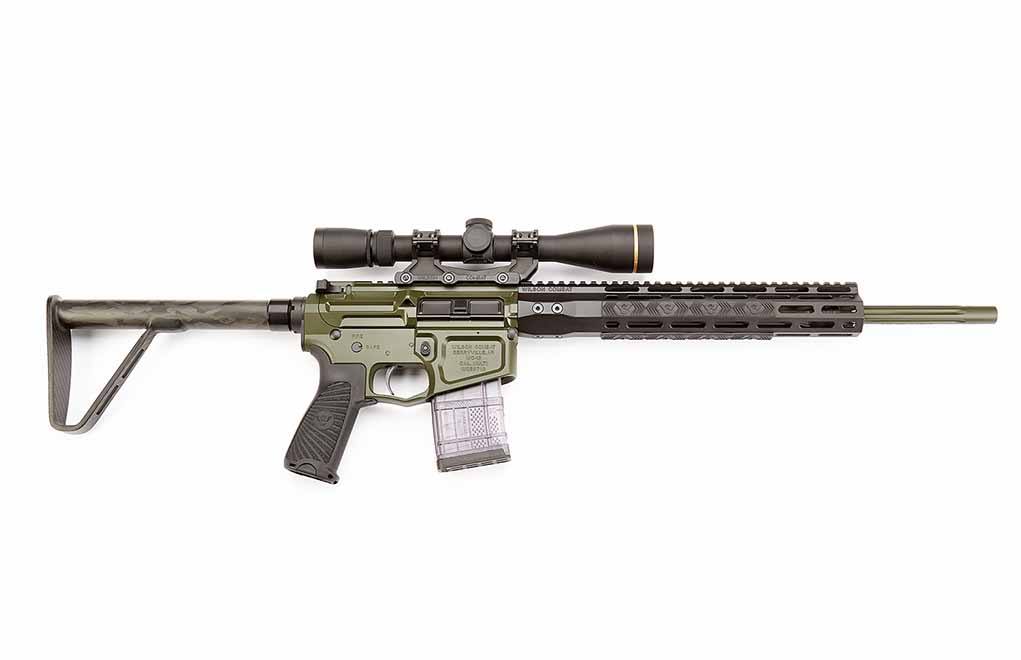
But why?
“I wanted something that would be effective at hunting most animals in North America — in a small, light package,” Wilson said.
Of course, Wilson already knew about and used the 6.8 SPC, the .300 BLK, the 5.56 NATO, his own 7.62x40mm and a host of other cartridges in his preferred WC semi-automatic platforms … yet he wanted more. Why? Maybe it was the perfectionist in him. Maybe it was his constant tinkering mind. Maybe it was because he simply could demand more, or maybe it was a combination of all three.
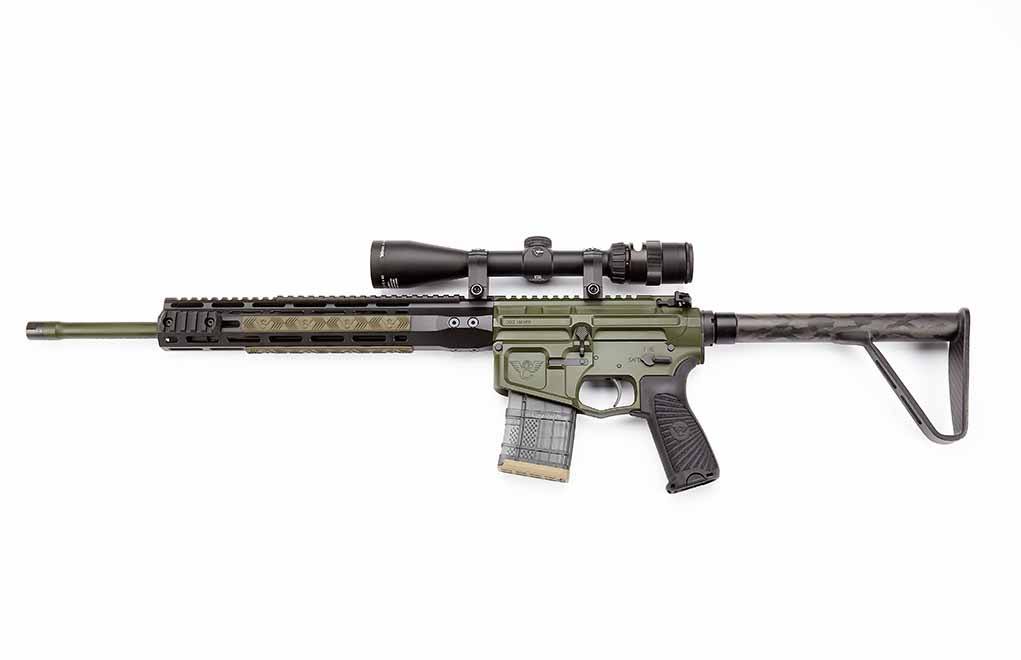
Regardless, for more than a decade, Bill Wilson whittled away at his idea of the perfect “practical range” gun. Note: Bill considers ranges out to 250 yards as practical hunting distances. “I can count on two hands — probably one hand — the number of times I’ve had to shoot farther than 250 yards,” he added. “I’ve always just gotten closer to my targets.”
Some early users of the .300 HAM’R have dubbed the AR-15 cartridge as the “modern day .30-30 Winchester,” which is quite the endorsement, referencing one of the most popular and successful hunting cartridges of all time. The team at Wilson Combat — and longtime friend of Wilson and fellow gun writer, Terrill Hoffman — thought so, too.
Need More AR Knowledge:
- 7 Affordable 9mm Carbine Options
- Top Options In AR Pistols From Daniel Defense
- Properly Using A Defensive AR-15 From Cover
- Should You Own A Pistol Caliber Carbine?
“During the early testing, we were calling it the .30-30 AR,” said Wilson. “That was the name on the original chamber reamer print and what we engraved on early test barrels. My buddy, Terrill, said something to the effect of, ‘Only us old guys know and care much about the old thuty-thuty.’ So, we came up with a bunch of potential names, and my son, Ryan, said, ‘We just came out with the .458 HAM’R and we have a trademark on HAM’R … so let’s call it the .300 HAM’R!’
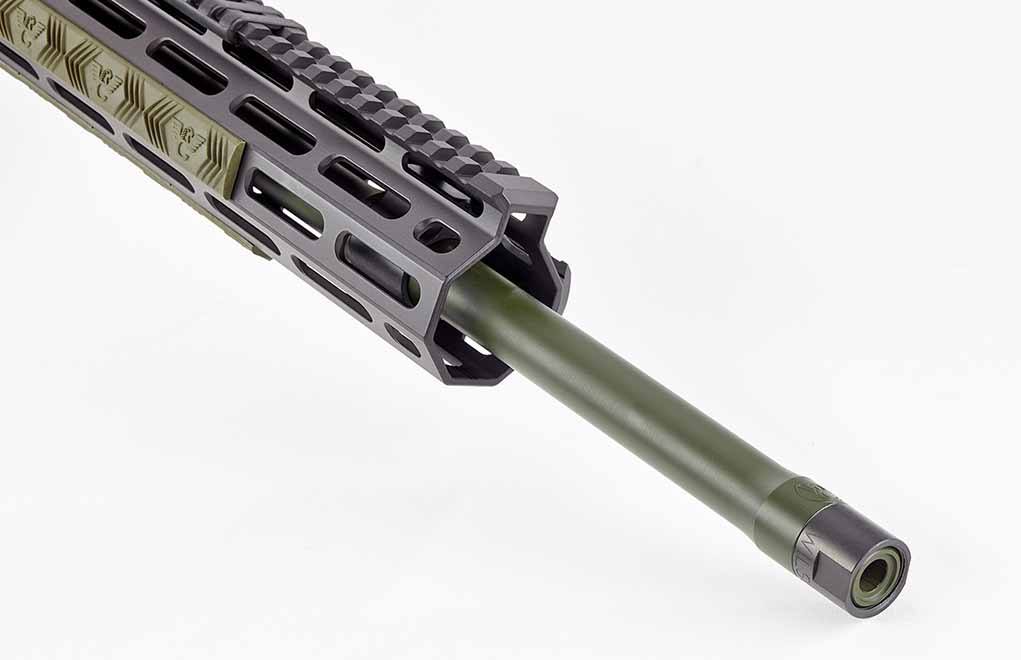
“Now, 13 years later, after thousands of rounds downrange, several scrap barrels and hundreds of dead Texas feral hogs, we have the .300 HAM’R that not only meets all of my original goals, but it exceeds them.”
Not surprisingly, Wilson’s research and results back up his claims.
Why The .300 HAM’R Is Worth A Look
Wilson Combat’s website serves host to Bill’s own testimony that terminal performance testing, on more than 200 Texas feral hogs, has proven the .300 HAM’R to kill much more effectively than the 6.5 Grendel, 6.8 SPC, 7.62×39 or 300 BLK. Again, that’s on the Wilson Combat website, but it’s a bold statement.

One of the reasons the .300 HAM’R is Wilson’s favorite is because of its designed accuracy.
“I really like accurate guns, and it’s laser accurate,” said Wilson. He credits the cartridge’s accuracy to its marriage of bullet weights to twist rates.
“Accuracy has proven to be outstanding,” he added. “Sub MOA groups are the norm with multiple bullet choices for varying applications, such as hunting, target shooting and tactical use.”
Wilson didn’t try one or even two different recipes to get bullets to stabilize: He was thorough.
.300 HAM'R Vs. .300 Blackout
| .300 HAM’R | .300 BLACKOUT |
| 16.25-inch barrel | 16.25-inch barrel |
| Sierra 110-grain HP: 2,600 fps @ muzzle, 1,651 ft-lbs. @ muzzle | Hornady Black 110-grain V-MAX: 2,395 fps @ muzzle, 1,401 ft-lbs. @ muzzle |
| Sierra 125-grain SBT: 2,520 fps @ muzzle, 1,763 ft-lbs. @ muzzle | Hornady 125-grain HP American Gunner: 2,175 fps @ muzzle, 1,313 ft-lbs. @ muzzle |
| Sierra 135-grain HP Varminter: 2,400 fps @ muzzle, 1,727 ft-lbs. @ muzzle | Hornady 135-grain FTX: 2,055 fps @ muzzle, 1,266 ft-lbs. @ muzzle |
| Hornady 150-grain SST: 2,240 fps @ muzzle, 1,671 ft-lbs. @ muzzle | Federal 150-grain Fusion: 1,900 fps @ muzzle, 1,202 ft-lbs. @ muzzle |
“I did a lot of work finding the right twist rate for the .300 HAM’R,” said Wilson. “We ran everything from 1:10, 1:11, 1:12, 1:13 and 1:14, and ultimately what we learned was the 1:15 twist rate gave us the best accuracy with consistent ½-inch groups — and my best three-shot group measuring .160 at 100 yards. The 1:15 twist rate is right at the cutting edge for stability in the 125- to 130-grain bullets. The 130-grain bullet running at about 2,520 fps is the sweet spot for the .300 HAM’R. I’ve found that the 130-grain Speer Hot Core and the 150-grain Hornady SST bullets work the best.”
Built Around the WC15
One big advantage of the .300 HAM’R is that it comes in a Wilson Combat semi-auto rifle. I’ve been fortunate enough to hunt with Wilson for pigs and Nilgai, using all three WC platforms: the WC10, the WC12 and the WC15 — and every experience has been mechanically superb with flawless terminal performance from any cartridge he recommended during the hunts. Regardless of the cartridge a gun owner chooses, Wilson Combat rifles are some of the best available because of that same attention to detail and perfection, which helped create the .300 HAM’R.
“We’ve spared no expense in development, testing and production of our rifles,” said Wilson. “If we could build a better one — we would. A big advantage Wilson Combat has is the fact that I’ve been a serious hunter since the early ‘70s, and I obviously have a very keen personal interest in Wilson Combat making the very best ARs on the market, whether for hunting or tactical use.
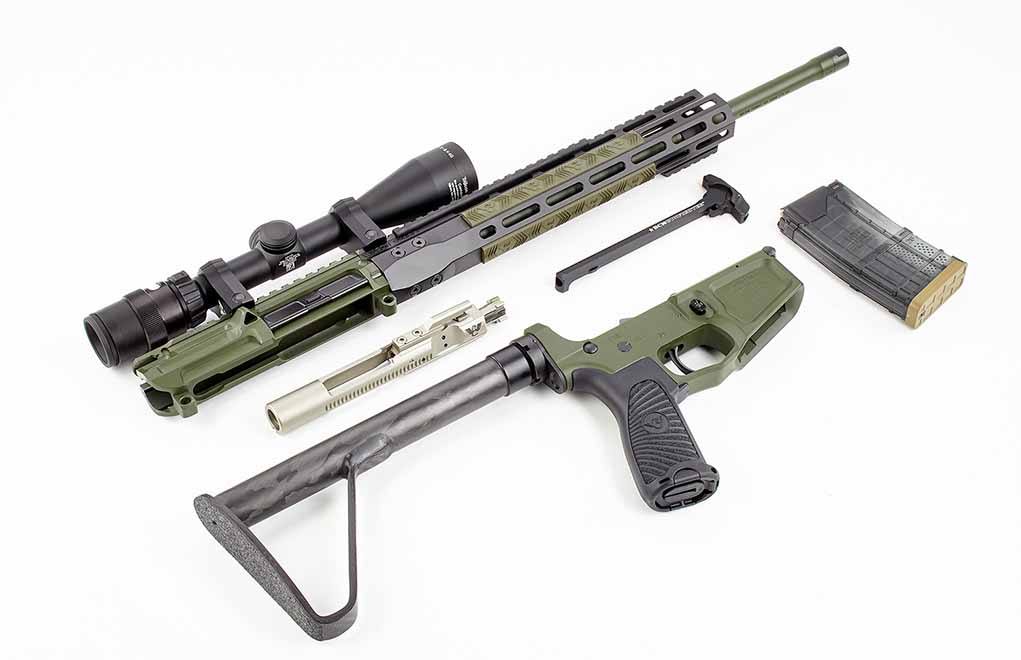
“I’m shooting and testing AR product virtually on a daily basis” he added. “Here at the ranch, we’re fortunate to have shooting ranges out to 800 yards for extensive accuracy testing. Also, I hog hunt at least 325 days out of the year, and I’m also deer hunting more than 120 days a year, with annual harvests of 200-plus hogs and 50-plus deer, all with ARs. Who else proves their product like that?”
The .300 HAM’R is available in five different WC15 configurations: The Ultralight Ranger, the Ranger, the Ultralight Hunter, the Tactical Hunter and the Bill Wilson Ranch Rifle package.
Lastly, during a recent phone interview with Wilson about this cartridge, he informed me he was headed to an elk hunt with his new .300 HAM’R. Yes, Wilson sees his .300 HAM’R as an elk gun — he sees it as a hog, deer, black bear, coyote and pronghorn gun, too.
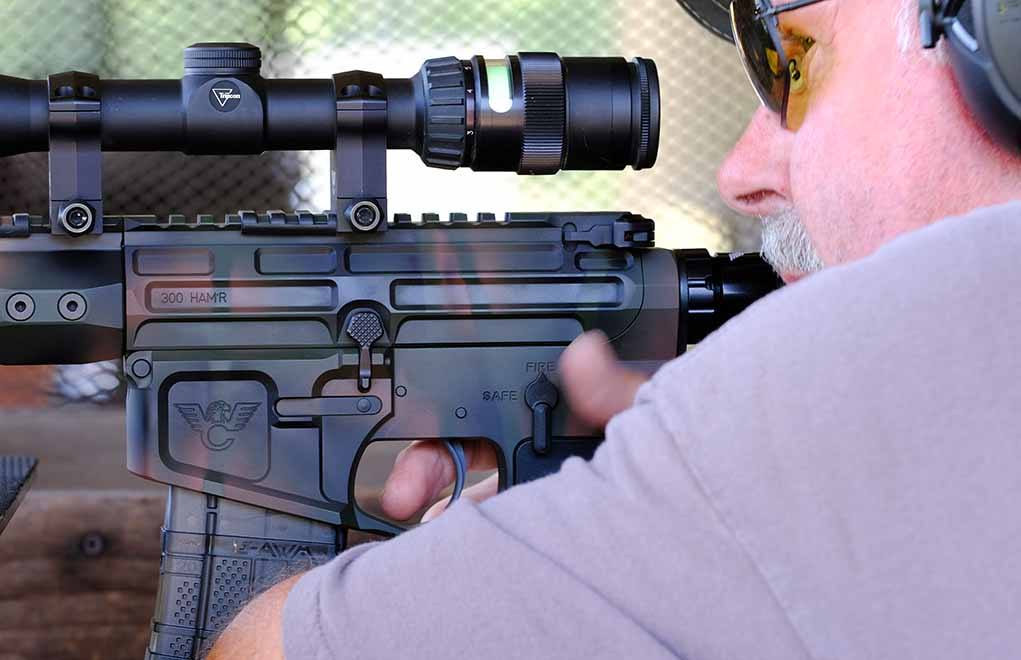
In typical Bill Wilson style, a few days later he backed up his words with results. While I was copyediting this story, I got an email from Bill Wilson telling me he just shot a 4×5 management bull elk at 175 yards with his .300 HAM’R, loaded with a Hornady 150-grain SST.
“The bullet entrance was 6 inches behind the front shoulder, and the perfectly expanded bullet was recovered under the skin on the off-side shoulder,” Wilson said. “I’m guessing 75 percent weight retention. The elk ran 20 yards and was down. I don’t know how you could ask for more.”
No, Bill Wilson: I don’t know how I could ask for anything more — but chances are good that, if there’s more to be had, you’ll find it.
For more information on the .300 HAM'r, please visit www.wilsoncombat.com.
Editor's Note: This article originally appeared in the December 2018 issue of Gun Digest the Magazine.

Next Step: Get your FREE Printable Target Pack
Enhance your shooting precision with our 62 MOA Targets, perfect for rifles and handguns. Crafted in collaboration with Storm Tactical for accuracy and versatility.
Subscribe to the Gun Digest email newsletter and get your downloadable target pack sent straight to your inbox. Stay updated with the latest firearms info in the industry.

![Best Concealed Carry Guns In 2025 [Field Tested] Wilson Combat EDC X9S 1](https://gundigest.com/wp-content/uploads/Wilson-Combat-EDC-X9S-1-324x160.jpg)


![Best 9mm Carbine: Affordable PCCs [Tested] Ruger Carbine Shooting](https://gundigest.com/wp-content/uploads/Ruger-Carbine-Shooting-100x70.jpg)
![Best AR-15: Top Options Available Today [Field Tested] Harrington and Richardson PSA XM177E2 feature](https://gundigest.com/wp-content/uploads/Harrington-and-Richardson-PSA-XM177E2-feature-100x70.jpg)

Being I’m not seeing any previous comments, I’m going to risk this thought hasn’t been expressed.
At least as good…for some maybe better?…would be the .300 HAM’r in a box magazine fed bolt action with. of course, the same barrel options and configurations.
What think ye?